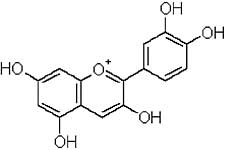FRUIT AS MEDICINE
Morus Fruit (Mulberry)
by Subhuti Dharmananda, Ph.D., Director, Institute for Traditional Medicine, Portland, Oregon
Morus fruit from Morus alba, the mulberry plant, is often called mulberry fruit. Although there are many species of Morus, the one grown in China is the white mulberry (alba = white). One of the primary uses of the plant is for raising silkworms, which utilize the leaves as their main food source.
China has been producing silk since ancient times and remains one of the world's primary sources. The Chinese term for the mulberry plant is sang, and the fruits are known in China as sanshenzi or simply sangshen. The fruit is botanically called a sorosis, because it is formed by the consolidation of many flowers. It is juicy and has a sweet taste with some sourness that is more prominent in the less mature fruits.
Mulberry fruit is classified in the modern Chinese Materia Medica as a blood tonic, and is listed along with herbs having similar traditional uses such as ho-shou-wu (Polygonum multiflorum, root), cooked rehmannia (Rehmannia glutinosa, root), ligustrum (Ligustrum lucidum, fruit) and lycium (Lycium chinensis, fruit).
Traditionally, mulberry fruit has been used as a medicinal agent to nourish the yin and blood, benefit the kidneys, and treat weakness, fatigue, anemia, and premature graying of hair. It is also used utilized to treat urinary incontinence, tinnitus, dizziness, and constipation in the elderly and the anemic.
The dominant taste of the ripe fruit is sweet but usually somewhat bland, due to the high water content and low level of other flavoring ingredients, but a richer flavor develops if the fruit is dried; it can then be used as a raisin substitute. In recent years, with considerable work on cultivating the mulberry plants under various conditions, mulberry enzyme has been commercially produced as a health beverage, and it has become very popular in China, Japan, and Korea.
The mulberry fresh fruit constituents:-
Water: 85-88%
Carbohydrate (sugars, mainly glucose and fructose, producing the sweet taste): 7.8-9.2%
Protein: 0.4-1.5%
Fat (mainly fatty acids, such as linoleic, stearic, and oleic acids in the seeds): 0.4-0.5%
Free acids (mainly malic acid, producing the sour taste): 1.1-1.9%
Fiber: 0.9-1.4%
Minerals: 0.7-0.9%
You probably never heard about mulberry enzyme drinks until now. You may know silkworms, which eat mulberry leaves and spin cocoons. Mulberry leaves are always used to feed silkworm and mulberry fruit is usually discarded. The mulberry enzyme drinks enhance your health, such as yin nourishing, enriching the blood, tonifying the liver and kidney, calming the nerves, promoting the metabolism of alcohol, balancing internal secretions, and enhancing immunity.
Nutritious and Bright
Mulberry is a kind of nourishing tonic medicine that can broadly be used to cure some debility symptoms when used with other restoratives. The person who has symptoms such as anemia, dizziness, or low libido, can take mulberry enzyme to build up health. An electuary, made from a prescription of mulberry with medlar, ligustrum, and schizandra, can nourish and enrich the blood; the wine made by immersing the mulberry in rice wine or grape wine, is a medicament for weakness after diseases that can also be used to tonify masculine vitality and benefit overall vitality.
Mulberry can nourish and promote production of body fluid. The person who has body fluid deficiency often feels their mouth parched and tongue scorched. When mulberry is ripe in the summer, a person can take one ounce every day. This product has a faint scent and sweet taste, suitable for people of all ages. Brew water to take the dry fruit, using 10 grams each time. The person who has dry eyes and uses their eyes a lot during work can drink mulberry enzyme, which can nourish the body fluid and strengthen sight.
Mulberry contains plentiful nutritious elements, such as minerals and vitamins; it can cure chronic diseases of the digestive tract, promote gastric juice secretion, strengthen the ability for digesting and assimilating, improve the appetite, and eliminate abdominal distention and constipation. Mulberry is suitable also for chronic gastritis and chronic hepatitis.
Nourishing Blood and Blacken Hair
Mulberry has the function of nourishing blood. If the person who has anemia, pallor, dizziness, insomnia, and heart-palpitations regularly takes mulberry juice or enzyme, they will experience good effects. Women who have the above symptoms after childbirth, or anyone after a long-time sickness or after a major operation, can take mulberry frequently as a restorative. Compounding with other herbs to make Wuchang, mulberry is combined with tang-kuei, ligustrum, and rehmannia.
A prescription or compound such as Wuchang can nourish blood, blacken hair, and help grow hair. Those who experience premature aging, such as graying hair and impotence, can take mulberry often. The pill, electuary, and wine all have high efficacy. The effect will be better for blackening hair and beautifying when it is combined with tang-kuei, ho-shou-wu, and drynaria. The mulberry juice can also be applied topically to the head to promote healthy hair growth.
HOW DOES MORUS FRUIT PRODUCE MEDICINAL EFFECTS?
The Chinese Materia Medica features numerous materials that are used as foods, including grains (wheat, millet, etc.), fruits (jujube, walnut), beans (soybeans, mung beans), and meats (oyster, pork). From the perspective of Western medicine, these are all useful as nutrient sources with obvious value to those suffering from various nutrient deficiencies, but they are usually not considered to have a therapeutic value. On the other hand, it is found by modern research that some foods contain additional non-nutrient ingredients that can have a distinct health impact.
A good example is the isolation and characterization of isoflavones from soybeans. Soy is considered an excellent source of protein, and also a source of vitamins (especially vitamin E in its oil); the isoflavones, if consumed in sufficient quantity, can have a significant hormone-like action.
Though not studied intensively, mulberry fruits appear to contain one main class of non-nutrient active constituents, which are the anthocyanins. In particular, it is known to contain cyanin (the structure presented here), which contributes the red pigment that gives the fruit a red to purple color. The content in ripe fruits is about 0.2%; an ounce of fruit would provide about 60 mg anthocyanins. The dried fruits are used in doses of 9-15 grams per day in decoction, and this can yield about 90-150 mg of anthocyanins. In Chinese diets, this component may have been low, in which case, such herbal supplements (decoctions or juices) can be an important source. |  |
In the U.S. today, with its rich resources in fruits that contain anthoycanins, it is estimated that adults consume about 180-215 mg/day of these components. A particularly rich source is blueberries; other major sources are cherries, black currants, bilberries, and other fruits with red, blue, or purple color. Still, a substantial increase in intake of anthocyanins, such as through morus fruit in herb formulas or beverages, could bring the dosage to a range where it has a more notable health impact. Studies with anthocyanins in laboratory animals suggest antioxidant activity as a dominant feature, but also cardiovascular protection, immune enhancement, antiviral activity, and stress reduction as potential health benefits.
One cannot be certain that all, or any, of the claimed benefits of consuming morus fruit are valid. However, if we assume that a health benefit was obtained, several considerations may help us understand the action of the fruit:
- Deficiencies in Chinese diets may have contributed to those problems mentioned as being remedied by morus fruit, such as anemia, constipation, premature graying of hair, etc. While morus fruit contains some nutrients (e.g., small amounts of calcium, iron, vitamin C, and B-vitamins), the anthocyanins may have improved blood circulation and other body functions to alleviate some symptoms that arise under the deficiency conditions.
- The specific benefits described in Chinese books may not be fully realized by people who have a good diet, because these individuals already receive adequate levels of the active components. However, other benefits or enhanced benefits still may be obtained by virtue of getting a higher dose of the active constituents.
- Modern study of active constituents provides a basis for expanding the therapeutic benefit of herbs. For example, a patient who is prescribed an herb formula containing morus fruit might be told to additionally consume of other fruits (e.g., blue berries, cherries) or their juices. The black mulberry (Morus nigra) develops a richer tasting fruit than the white mulberry, and it can be consumed as a fresh fruit, juice, or jam. Thus, it is not necessary to rely solely on the Chinese herb ingredient to attain the desired results.
- Chinese herb therapies (as complex formulas) may address a health problem by using a group of several herbs that have a similar end effect, but with different active components and different mechanisms. For example, a formula comprised of morus fruit, ho-shou-wu, rehmannia, and ligustrum may nourish blood, alleviate constipation, and have antioxidant and antiaging effects, but each herb contributes a different group of active components: anthocyanins, anthoquinones, iridoid glycosides, and oleanolic acid, respectively. Together, these may reduce adverse oxidative reactions, enhance circulation, alleviate inflammatory processes that yield systemic consequences, and improve the digestion and absorption of nutrients while enhancing the elimination of waste products of metabolism.

Mulberry cultivation areas in China
COMBINING OTHER HERBS WITH MORUS FRUIT
The following are examples of recommendations for use of morus fruit with other herbs to treat certain conditions:
- For deficient yin and blood manifested as dizziness, vertigo, blurred vision, tinnitus, deafness, insomnia and early graying of hair, mulberry fruit is used with ho-shou-wu, ligustrum, and eclipta in the formula Shouwu Yanshou Dan. This combination can also be used for constipation in the elderly and for post-partum recovery. Ligustrum and eclipta together make a basic formula called Erzhi Wan, a well-known formula for yin deficiency with graying of the hair.
- For thirst and dry mouth due to deficient body fluids or diabetes, manifesting as thirst with desire to drink, profuse urine, and lassitude, mulberry fruit is used with ophiopogon, ligustrum, and trichosanthes root; alternatively, one can combine it with ophiopogon, glehnia or adenophora, and yu-chu.
- For constipation due to dryness in the intestines, mulberry fruit is used with black sesame seed, ho-shou-wu, and hemp seed (which can be substituted by flax seed).
- For chronic arthritis, mulberry fruit is used with ho-shou-wu and chin-chiu (qinjiao).
- For nervous stress, mulberry fruit is combined with schizandra and ligustrum.
- For insomnia, mulberry fruit is used with zizyphus, tang-kuei, and hoelen (or fu-shen). Mulberry fruit can also be combined with rehmannia (both cooked and raw) to alleviate insomnia due to blood and yin deficiency.
In Chinese markets, mulberry is often provided in the form of a paste called sangshengao. The paste is mixed into hot water to make a tea to enrich the liver and kidney and sharpen the hearing and brighten the eyes. For this application, it can be combined with the traditional formula Yiqi Congming Tang, which is used for deficiencies in hearing and vision, particularly in the elderly who suffer from deficiency of yin with deficient heat.
APPENDIX: Food and Medicine Uses of Mulberries in Azerbaijan
Following is part of a story (The origin of mulberry trees by Farid Alakbarov and Iskandar Aliyev) that appeared in Azerbaijan International, Autumn 2000.
Fresh mulberries are so fragile and perishable that they have not yet been grown commercially in the United States, making them very rare and sought after-especially in California. Restaurant chefs have been known to line up for hours at outdoor markets to buy these fashionable berries at $10 to $15 a pound. In the Los Angeles area, some Iranian immigrants have even resorted to planting their own mulberry orchards so that they will have easy access to their favorite fruit. But in Baku, the capital city of Azerbaijan, mulberry trees can be found in parks and lining streets and boulevards. It's one of the favorite fruits.
This sweet, juicy berry is by no means a newcomer to Azerbaijan. By the Middle Ages, there were already many different types of mulberries in the region. There are three main species of mulberries-white, red and black-all of them widely cultivated throughout Azerbaijan. The white mulberry, in particular, grows in the forests stretched along the Kur, Araz, and Samur rivers.
To pick mulberries, a person-often a young boy-climbs the tree and shakes the branches, causing the fruit to drop onto a cloth or plastic sheet below. The berries are very delicate and therefore need to be handled carefully so that they don't break open-the stain won't wash out. Azerbaijanis don't grow mulberry trees just for their fruit, however. In the summer, residents in the villages around Baku used to sit and drink tea or play nard (backgammon) in the cool shade of mulberry trees. There is a square in the Old City (Ichari Shahar) that takes its name after the tree. Even a song has been written about the mulberry tree.
 | Today, mulberry trees (most frequently those bearing black fruit) line the streets of Baku and lend shade to courtyards. In the countryside, mulberry trees are often found in orchards and courtyards, along with a variety of other fruit trees like cherry, fig, pomegranate, apricot, apple and pear. Originally, male (fruitless) mulberry trees were planted along the streets and in the parks of Baku in order to provide shade and decoration. But somehow it happened that some female trees got planted as well. When their fruit becomes ripe each June, it tends to drop to the ground and stain the sidewalks. That's how you know it's mulberry season in Azerbaijan-that and kids' faces stained with the dark purple juice.
When mulberries are no longer in season, Azerbaijanis still enjoy eating them in the form of mulberry syrup concentrates known as doshab and bakmaz. To make the syrup, mulberry juice is boiled until it has a consistency that's much like honey.
While this syrup makes a tasty sweet, it is also used as a medicine to protect against diseases of the liver, gall bladder, and heart. To treat gallbladder infections, one is supposed to drink 2 tablespoons of bakmaz dissolved in half a glass of water, then lie down in bed on his or her right side. The treatment should be taken on an empty stomach, half an hour before breakfast. Bakmaz is used to treat sore throats as well. Tut araghi, a potent liqueur made from mulberry juice, is another mulberry product that's very popular-not only Azerbaijan, but also in Georgia and Armenia. It's one of the national Azerbaijani versions of vodka. Some people believe that small doses of the drink protect against diseases of the stomach and heart. |



 Learn more about this author, Jennifer Kirkman.
Learn more about this author, Jennifer Kirkman.